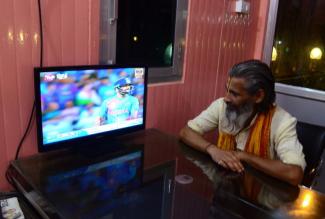Television
Money matters

Earlier this year, Pranav Dhanawade, a 15 year old from Kalyan in the state of Maharashtra broke more than a century old world record for most runs scored in a single inning. He amassed 1009 runs in an under-16 inter-school tournament game.
The teenager’s feat was celebrated excessively by the country’s mainstream media. But what was ignored was the overwhelmingly one-sided nature of the match. Given the constitution of the opposing side, Dhanawade’s team was so strong that it did not need most of his runs. The other school’s coach had decided to rely on much younger students because most of his U-16 players were absent. His two main bowlers were aged around 10. They had not held a full-sized ball in their tiny hands or bowled on a standard 22 yards pitch ever before.
Schools should encourage young students to embrace the values of fairness, respect, comradeship and love of sports. In this case, however, a youngster was unfortunately egged on to ruthlessly pursue personal ambitions. Dhanawade is too young to be at fault. The team administrators should have intervened and stopped his silly display of triumphalism.
That they did not do so is linked to the political-economic context. Cricket has been redefined again and again in India, and the process has weakened its ethical sinews and robbed it of communitarian values. The Gentleman’s Game, as it was once known, is now big business and it has, under commercial pressure, become extremely competitive.
Attracting the masses
Today, a promising young cricketer may earn as much as the equivalent of an annual $ 1.25 million in the Indian Premier League. With a few good years of performance, he could emerge as a star and advertising brand and may make $ 20 million.
A distinctive product of the British Imperialism, cricket was always a very popular sport in India. In the past decades, however, a new international format of one-day games called Twenty20 was introduced. They are much shorter than the languid classic five-day test matches version, though they still take four times as long as a football match. This innovation won over new constituencies which earlier had found cricket with its complex and arcane rules boring.
In 1983, India unexpectedly won the World Cup against with the West Indies, which had a reputation for invincibility. The World Cup in 1987 was hosted jointly by India and Pakistan, boosting the popularity of the sport in the country even more. Henceforth, any public place, no matter what size, could become the ground for a cricket game, with improvised equipment and rules to suit the setting. Cricket became the sport kids play in the streets, on playgrounds and even in school hallways.
Back then, cricket was still much less of a spectator state than it is today. The state monopoly on broadcasting and the extremely limited access to TV sets meant that far fewer people could follow matches. Cricket was actually played much more than it was watched. That was before India formally initiated its economic liberalisation programme in 1991 and opened its doors to the world.
Liberalised media
The story of cricket after ’91 is in many ways the story of India. India’s domestic market is huge, and the growth-oriented economic policy gave an impetus to the private sector. It also brought in substantial foreign investments. The consumer market grew fast, and so did the middle class. TV, and specifically cricket, turned out to be a bridge between the two.
In the past, India had a single state-owned TV network. Now, an average urban household in India today has access to several hundred private channels in various languages and genres, including dedicated cricket channels. Cricket has become a sport people, especially the middle class, consume at home. The excessive focus on it, however, has been crowing out other sports, including hockey, which got India eight of its nine Olympic gold medals so far.
According to estimates, India is now contributing well over 75 % of the International Cricket Council’s global revenues. The ICC is the sport’s governing body. The sums spent on sponsorships, broadcasting and licensing rights in India compares to any other popular sports elsewhere in the world. In October 2014, Star India and Star Middle East, which belong to 21st Century Fox, Rupert Murdoch’s US-based corporation, reportedly agreed to pay the ICC around $ 2 billion for the broadcasting rights for its events from 2015 to 2023. A single tournament today may fetch the ICC sponsorship revenues worth $ 60 million. Of such sums, 90 % is advertising by businesses interested in India’s market.
The Board of Control for Cricket in India (BCCI) has sometimes used its economic heft strategically – and mostly in a roughshod manner – to tilt the balance of power in its favour on the global cricket stage. For instance, it had referees removed, fought for the interests of its sponsors and resisted reforms in game administration, including anti-doping measures. On the other hand, it has been quite tolerant of corruption, both on and off field. The BCCI is run by powerful politicians. It has not fulfilled its mandate of building quality infrastructure and creating opportunities to support the game in a significant way.
Match-fixing scandals
Sports administration in India, by and large, has been a bastion of cronyism and corruption. To give but one example, the International Olympic Committee in 2014 suspended the Indian Olympic Association for 14 months. The reasons were corruption, government interference and a lack of guideline observance.
At the turn of the millennium, Indian cricket was rocked by several betting and match-fixing scandals. Several players were indicted, suspended, and banned for sharing game related information with bookmakers or agreeing to loose matches. For millions of fans, this was a low point. In the end, the Supreme Court intervened and appointed a three-member committee headed by a former chief justice of India to make recommendations on cleaning up the system.
In the meantime, some upwardly mobile sports fans had begun to cultivate interest in several other sports, including football, tennis and motorsports. Greater access to global media helped. To catch up again, the BCCI began to experiment with more television-friendly formats. The Indian Premier League, which relies on one-day games called Twenty20, was established. It helped to revive the sport’s fading popularity.
Cricket is no longer about participating or even playing oneself, but about consuming images of fierce competition, whether in public or private spaces. It has become a dividing practice, celebrating distance, difference and competition at the expense of contact, unity and cooperation.
Testing patriotism
Cricket is used as a crude political instrument to mark “others”. Support for the Indian team is considered a sign of patriotism, for example. Recently, 67 Indian students were arrested for cheering the Pakistani team in India. Things are not better in Pakistan, where a man, claiming to be a fan of Indian cricketer Virat Kohli, faces 10 years in jail for hoisting the Indian flag. Being an Indian Muslim, I was myself often asked as a child by taunting classmates whether I was happy about Pakistan winning a match.
Currently, sporting ties between the bitter rivals India and Pakistan are suspended because India accuses Pakistan of supporting terrorist groups. Similarly, the Indian state of Tamil Nadu has barred Sri Lankan sportsmen from playing on its territory in response to how ethnic Tamils are treated in the island nation. Political groups have petitioned the national government to not allow cricketers from the two neighbouring countries to play in the IPL. Given the shared love for the game in South Asia, it is ironical that the game has been used more often to polarise communities instead of strengthening relationships between them.
Cricket is the most popular sport in India. It has been thoroughly economised and politicised, but it still has the power to keep even a disenchanted fan in front of the TV set during a closely fought contest. Its future, however, rests on the ability of its administrators, votaries and fans to ease it from the unrelenting tyranny of the living room and bring it back into the galis and maidans (streets and parks). The only way to preserve the game is to keep playing it.
Faiz Ullah works for the School of Media and Cultural Studies at the Tata Institute of Social Sciences, Mumbai.
faiz.ullah@tiss.edu












